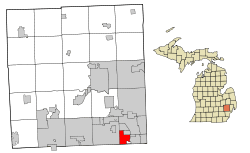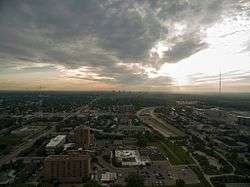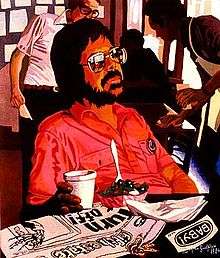Oak Park, Michigan
| Oak Park | |
|---|---|
| City | |
| City of Oak Park | |
|
Pedestrian plazas over Interstate 696 in Oak Park | |
| Motto: "The Family City" | |
 Location in the state of Michigan | |
| Coordinates: 42°28′2″N 83°10′46″W / 42.46722°N 83.17944°WCoordinates: 42°28′2″N 83°10′46″W / 42.46722°N 83.17944°W | |
| Country | United States |
| State | Michigan |
| County | Oakland |
| Incorporated |
1927 (village) 1945 (city) |
| Government | |
| • Mayor | Marian McClellan |
| Area[1] | |
| • City | 5.16 sq mi (13.36 km2) |
| • Land | 5.16 sq mi (13.36 km2) |
| • Water | 0 sq mi (0 km2) |
| Elevation | 666 ft (203 m) |
| Population (2010)[2] | |
| • City | 29,319 |
| • Estimate (2012[3]) | 29,594 |
| • Density | 5,682.0/sq mi (2,193.8/km2) |
| • Metro | 5,456,428 |
| Time zone | EST (UTC-5) |
| • Summer (DST) | EDT (UTC-4) |
| ZIP code | 48237 |
| Area code(s) | 248, 313 |
| FIPS code | 26-59920[4] |
| GNIS feature ID | 0633849[5] |
| Website | http://www.ci.oak-park.mi.us/ |
Oak Park is a city in south Oakland County of the U.S. state of Michigan. It is a northern suburb of the city of Detroit, which is located in neighboring Wayne County, and part of its metropolitan area. As of the 2010 census, the population of Oak Park is 29,319.
History
This area was designated as within Royal Oak Township; it was first settled by European Americans in 1840, but remained sparsely populated for many decades following. The first major housing development was constructed in 1914 at the time of World War I, when the township sold land to the Majestic Land Company to be developed as the Oak Park subdivision.[6] The subdivision was incorporated as a village on May 3, 1927. Two petition drives during the Great Depression to dissolve the village government and return it to the township, citing "excessively high cost of village government," failed in 1931 and 1933, respectively.[6] The village incorporated as city on October 29, 1945 following the end of World War II.
Stimulated by the GI Bill which aided veterans in buying new housing, highways to improve commuting, and planned developments in the late 1950s, Oak Park from 1950 to 1960 was named as "America's Fastest Growing City".[7] Its population increased sevenfold, from 5,000 to more than 36,000. Much of its population were second and third-generation children of European immigrants who had settled in Detroit in the early 20th century. These included many Jewish Americans descended from immigrant ancestors from the Russian Empire, including present-day Poland and Ukraine. Major civic improvements in this period included construction of an outdoor swimming pool and an ice rink in Major Park (now known as Shepherd Park, after former mayor David Shepherd, but long known informally as Oak Park Park).
In 1995 Detroit based window manufacturer, WeatherGard moved its headquarters to Oak Park.
In 2002 and 2004, the city annexed portions of neighboring Royal Oak Township to expand its land and tax base.[8]
On November 8, 2011 the citizens of Oak Park elected a new mayor, Marian McClellan. Mayor McClellan is the city's first new mayor in 22 years, replacing the long-serving Jerry Naftaly.
In April 2015, the city approved the development of a new FedEx distribution center which will be located on a 60-acre plot of land at the site of the former Detroit Artillery Armory.[9]
On May 5, 2015 the citizens of Oak Park voted to allow mixed drinks to be sold at businesses within city limits; in addition to beer and wine which was previously allowed.[10]
On November 3, 2015 the citizens of Oak Park re-elected Marian McClellan who was running against Aaron Tobin, who was also running for the position of Mayor of Oak Park.
Geography
According to the United States Census Bureau, the city has a total area of 5.16 square miles (13.36 km2), all of it land.[1]
Demographics
| Historical population | |||
|---|---|---|---|
| Census | Pop. | %± | |
| 1930 | 1,079 | — | |
| 1940 | 1,169 | 8.3% | |
| 1950 | 5,267 | 350.6% | |
| 1960 | 36,632 | 595.5% | |
| 1970 | 36,762 | 0.4% | |
| 1980 | 31,537 | −14.2% | |
| 1990 | 30,468 | −3.4% | |
| 2000 | 29,739 | −2.4% | |
| 2010 | 29,319 | −1.4% | |
| Est. 2015 | 29,752 | [11] | 1.5% |
2010 census
As of the census[2] of 2010, there were 29,319 people, 11,719 households, and 7,533 families residing in the city. The population density was 5,682.0 inhabitants per square mile (2,193.8/km2). There were 12,782 housing units at an average density of 2,477.1 per square mile (956.4/km2). The racial makeup of the city was 37.4% White, 57.4% African American, 0.2% Native American, 1.4% Asian, 0.5% from other races, and 3.0% from two or more races. Hispanic or Latino of any race were 1.4% of the population.
There were 11,719 households of which 33.3% had children under the age of 18 living with them, 35.4% were married couples living together, 23.9% had a female householder with no husband present, 5.1% had a male householder with no wife present, and 35.7% were non-families. 30.9% of all households were made up of individuals and 11% had someone living alone who was 65 years of age or older. The average household size was 2.50 and the average family size was 3.16.
The median age in the city was 37.5 years. 24.9% of residents were under the age of 18; 9.6% were between the ages of 18 and 24; 25.7% were from 25 to 44; 26.9% were from 45 to 64; and 12.9% were 65 years of age or older. The gender makeup of the city was 45.1% male and 54.9% female.
2000 census
As of the census[4] of 2000, there are 29,793 people, 11,104 households, and 7,595 families residing in the city. The population density is 2,291.5/km² (5,932.0/mi²). There are 11,370 housing units at an average density of 874.5/km² (2,263.9/mi²). The racial makeup of the city is 46.95% White, 45.95% African American, 0.17% Native American, 2.18% Asian, 0.02% Pacific Islander, 0.60% from other races, and 4.13% from two or more races. 1.28% of the population are Hispanic or Latino of any race.
There are 11,104 households out of which 34.4% have children under the age of 18 living with them, 44.0% are married couples living together, 19.5% have a female householder with no husband present, and 31.6% are non-families. 26.6% of all households are made up of individuals and 10.4% have someone living alone who is 65 years of age or older. The average household size is 2.68 and the average family size is 3.29.
In the city the population is spread out with 28.2% under the age of 18, 8.0% from 18 to 24, 29.8% from 25 to 44, 21.8% from 45 to 64, and 12.2% who are 65 years of age or older. The median age is 35 years. For every 100 females there are 88.0 males. For every 100 females age 18 and over, there are 81.9 males.
The median income for a household in the city is $48,697, and the median income for a family is $54,786. Males have a median income of $40,922 versus $35,968 for females. The per capita income for the city is $21,677. 9.4% of the population and 7.8% of families are below the poverty line. Out of the total population, 10.9% of those under the age of 18 and 13.9% of those 65 and older are living below the poverty line.
Notable people
- Jamie Arnold, American-Israeli professional basketball player with Hapoel Holon
- Rube and Liz Weiss, Well-known Detroit actors, lived in Oak Park during the mid-20th century[13]
- Larry Downes, co-author of Unleashing the Killer App: Digital Strategies for Market Dominance and writer for Forbes, was raised in Oak Park.
- Robert Ettinger, known as the father of cryonics human preservation, lived in Oak Park for decades.
- Al Kaline, Detroit Tiger baseball legend and Hall of Fame member, lived on Morton Street in the late 1950s.
- Ryan "Royce da 5'9"" Montgomery, Detroit rapper known for his association with Eminem as Bad Meets Evil and Slaughterhouse
- Norm Cash, baseball player for the Detroit Tigers from 1960-1974, lived a couple of blocks from his teammate Al Kaline, on Sloman Street between Jerome and Saratoga.
- David Weiss (a.k.a. David Was) and Don Fagenson (a.k.a. Don Was), musicians from the group Was (Not Was), grew up together in Oak Park.
- Jeffrey Sachs, noted economist of Harvard University and currently at Columbia University, is a graduate of Oak Park High School.
- Geoffrey Fieger, attorney who represented Jack Kevorkian, grew up in Oak Park and graduated from Oak Park High School in 1969.
- Doug Fieger, musician, was the lead singer of the group The Knack; his hit songs included "My Sharona" and "Good Girls Don't".
- Jeffrey Seller, broadway producer and Tony Award winner, best known for his work on Rent, Avenue Q, In the Heights and Hamilton
- Curt Sobel, composer, film music editor and supervisor, grew up in Oak Park and lived on Northfield and Harding.
- Ron Suresha, author and editor, attended grade school in Oak Park and was graduated from OPHS.
- Mort Meisner, noted Detroit media guru, lived on Sunset Street.
- Bob Black, a prominent theorist of the international anarchist movement, and the author of the widely disseminated essay "The Abolition of Work;" he grew up in Oak Park and graduated from its high school.
- Peter Werbe, a radio talk show host, DJ, and political activist, has lived in Oak Park for 34 years. He hosted NightCall on Sunday nights on Detroit's WRIF 101.1 FM from 1970-2016, the longest running phone-in talk show in U.S. radio history He also is a staff member of the 52-year-old magazine, The Fifth Estate.[14]
- Dan and Tracee Miller, musicians in the band Blanche, they currently reside in Oak Park. Dan has acted in film and Tracee is also a visual artist.
- Joseph Bruce (Violent J) and Joseph Utsler (Shaggy 2 Dope), better known as Insane Clown Posse met in Oak Park. In 1989, Joseph Bruce, as Jagged Joe, Joseph Utsler, as Kangol Joe, and John Utsler, as Master J, released the single titled "Party at the Top of the Hill" under the name of JJ Boys.
- Jeff Bass and Mark Bass, record producers (Eminem, and Jeff on the 2015 monster hit Uptown Funk with Mark Ronson and Bruno Mars) were born and raised in Oak Park.
- Les Gold, owner of American Jewelry and Loan, and star of the TV show Hardcore Pawn lived in Oak Park for several years during his childhood.[15]]
- Carrie Keranen, American voice actress.
Education
Oak Park's educational history began with the Clinton School, a one-room schoolhouse on property donated by Barney Clinton in the early 20th century. As the population grew rapidly, Clinton School was expanded and more elementary schools were built, particularly beginning in the 1950s.
Clinton School was made a Junior High School and another was built in the mid 1960s, then named for the great American poet Robert Frost. At that time, one school in Oak Park had a special education department for children with learning disabilities: Lessenger Elementary School on Albany St. at Sunset St. Consequently, many families with such special children gravitated to the neighborhood surrounding Lessenger, creating a "cluster" of such families rarely found elsewhere.
Educational achievement was the long consistent pattern in Oak Park. Over 85% of Oak Park High School graduates continued their education immediately after high school, whether in college, or in trade or vocational schools. The school system was renowned statewide for decades in large part due to the efforts of progressive and dedicated teachers.
The high school had an average score of 3.8 on the state's MEAP test in 2011. This was one of the lowest scores in Oakland County.[16]
Students residing between 10 Mile Rd. and 11 Mile Rd. are in the Berkley School District. A square mile on the east end of Oak Park is in the neighboring Ferndale School District; the majority of the city is in Oak Park Schools.
Controversy
In July 2011 the City of Oak Park charged Julie Bass, a homeowner, for growing vegetables in her front yard. The vegetables were tomatoes, zucchinis, and peppers.[17]
In March 2015, Stephanie Sumner and Michael Sumner were fired from their positions as city employees after the city had discovered that the two had stolen $433,000 from the city over the course of two years. Several months after the story broke, the city announced that the stolen funds had been replaced through the city's insurance policy. However, many residents voiced their concerns regarding the potential insurance rate hikes that would occur after an insurance claim to replace the stolen money.[18]
References
- 1 2 "US Gazetteer files 2010". United States Census Bureau. Archived from the original on January 24, 2012. Retrieved 2012-11-25.
- 1 2 "American FactFinder". United States Census Bureau. Retrieved 2012-11-25.
- ↑ "Population Estimates". United States Census Bureau. Archived from the original on June 17, 2013. Retrieved 2013-06-03.
- 1 2 "American FactFinder". United States Census Bureau. Archived from the original on September 11, 2013. Retrieved 2008-01-31.
- ↑ U.S. Geological Survey Geographic Names Information System: Oak Park, Michigan
- 1 2 Bernadine Schoults, The History of Royal Oak, 1955
- ↑ Tova Stulman. "Oak Park/Southfield/West Bloomfield, A Trio of Jewish Boom Towns in Michigan". Archived from the original on July 17, 2011. Retrieved March 13, 2010.
- ↑ "City of Oak Park Michigan Comprehensive Annual Financial Report" (PDF). 2004.
- ↑ Pinho, Kirk. "FedEx to open distribution center at former Oak Park armory site, sources say". Crain's Detroit Business. Crain Communications, Inc. Retrieved 10 November 2015.
- ↑ Borka, Aftab. "Voters to decide on spirits sale in Oak Park on May 5". Oakland Press News. The Oakland Press. Retrieved 14 November 2015.
- ↑ "Annual Estimates of the Resident Population for Incorporated Places: April 1, 2010 to July 1, 2015". Retrieved July 2, 2016.
- ↑ "Census of Population and Housing". Census.gov. Archived from the original on May 11, 2015. Retrieved June 4, 2015.
- ↑ "Was (Not Was)--Biography, ZE Records". Archived from the original on August 13, 2011. Retrieved August 12, 2010.
- ↑ Fifth Estate (periodical)
- ↑ Schleier, Curt. "Q&A: 'Hardcore Pawn' Stars Les and Seth Gold". Forward. The Forward Association, Inc. Retrieved 10 November 2015.
- ↑ "DATABASE: Check your school's 2011 MEAP score". Detroit News. 2012-02-20. Retrieved 14:50, Monday February 20, 2012 (UTC). Check date values in:
|access-date=(help) - ↑ Vegetable garden brings criminal charges", ABC News, July 2011
- ↑ McConnell, Mike. "Ex Oak Park clerk to stand trial in theft of $433,000, all the money is spent, police say". The Daily Tribune Crime. The Daily Tribune.




